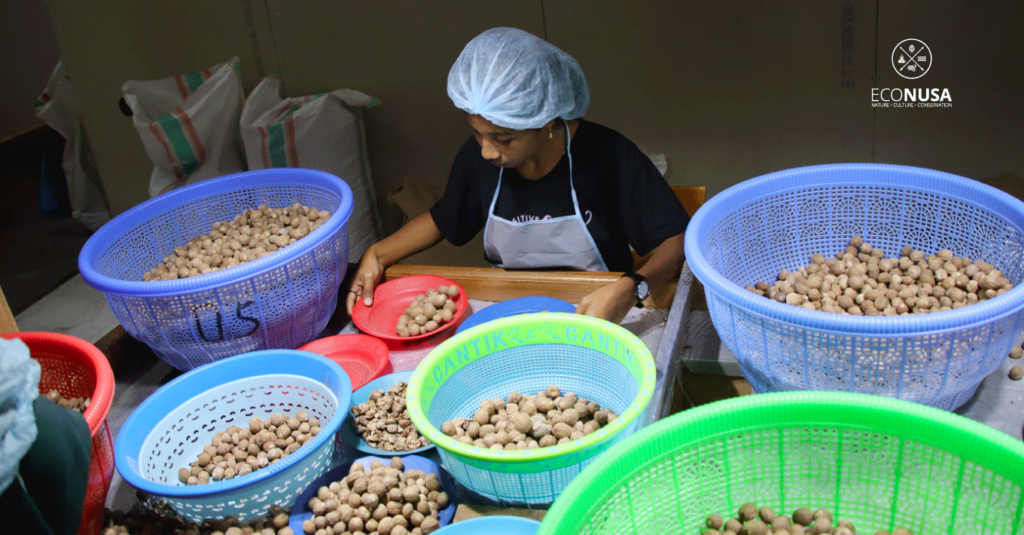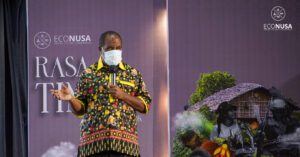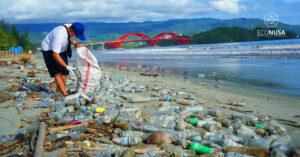
Nutmeg still becomes one of the most prominent Indonesian commodities including Kaimana Regency in West Papua. The priceless selling point has made Kaimana people plant nutmeg trees. The yields could provide benefits to growers, collectors, and businesspersons.
One of the businesspersons in Kaimana is Udin. He has warehouse in Air Merah compound. The Sulawesi born purchases nutmegs from nearly all villages in Kaimana. He has run the nutmeg business since 2003 by purchasing nutmegs from growers and local collectors in many villages. Initially he bought dozens of kilograms, but soon afterwards he could afford hundreds of tons of nutmegs.
In a day, Udin can buy 7 tons of nutmegs and fuli (nutmeg flower). To afford that large number of nutmegs, Udin spends Rp280 million. The amount here comes only from one businessperson. If there are six businesspersons buying nutmegs, this commodity could yield turnover worth billions of rupiahs in a month. The figure is large amount for such a small regency with 60 thousand population.
Read also: Arguni Bay, Nutmeg Stock and Kaimana Forest Commodities
The nutmeg trade is a very long chain. It begins from the growers who pick nutmegs. Picking nutmegs from the trees takes time for collection. They then peel them of f to separate the seed and fuli. From the peeled nutmeg, the flower is traditionally smoked to produce dried nutmegs. The fuli is then dried up on tarpaulin or fabric.
From these growers, the nutmegs are collected from the collectors at village level. The price varies which ranges from Rp35,000 to Rp40,000 per kilogram. The collectors bring them to the bigger agents to get Rp42,500 price per kilogram for shipping to Surabaya.
On Udin’s hands, the nutmegs are not directly delivered. He would dry them up and sort out the shaken nutmeg and the firm nutmeg for shipping to Surabaya, East Java. The shaken nutmeg is the nutmeg seeds that peeled off from its shell so it will produce sounds when shaken. The firm nutmeg is nutmeg with firm seed on its shell after several phases of drying.
Read also: Sasi Sambite: Local Wisdom to Boost Nutmeg Quality in Arguni Bawah
The shaken nutmeg has higher price or around Rp70,000 per kilogram. To produce shaken nutmegs, it should pick the ripen nutmeg. This is the major requirement before undertaking the drying process. However, growers are reluctant to pick this method. They are tempted to get fast cash for various reasons such as meal, school tuition, medication, and the likes.
However, it was the past practices prior to assistance provided by EcoNusa. Now, the growers have transformed their ways to process nutmegs. It starts from imposing a so-called sasi sambite, a customary ban, at the end of March 2020. The growers could no longer harvest nutmegs carelessly. They should comply with the customary sasi.

In practice, the customary sasi is divided into two. First is “closing sasi” which is intended to ban growers to crop their nutmegs up to a certain period. Second is “opening sasi” when the growers are allowed to crop their nutmegs. The harvested nutmegs should be the ripen one. None of the community dares to breach the customary law here. They believe that any violation will get punishment and curse from the ancestors. EcoNusa also assists the community in drying process and production of shaken nutmeg.
Last May, at least there were 25 growers who could produce shaken nutmeg. They commonly bring their 3 sacks of nutmeg directly to Udin. The Rp14 million income is so tempting. The nutmeg is put on the 50-kilogram sack. The sack could weigh around 52 kilograms.
The yield could be far different from the production before imposition of sasi and they crop unripe nutmeg. They could get 42 kilograms of nutmeg each sack at the heaviest. But it could contain mixed nutmeg. The young nutmeg flower is lighter than the ripe ones. From the ripe nutmeg crop, the growers could get 38 kilograms of nutmeg flower per sack. The price of nutmeg flower from Udin cost Rp210,000 per kilograms.
Read also: Boosting Nutmeg Productivity in Kaimana
The growers could afford domestic needs, building a house, and their children school tuition from their income. It is no wonder if Udin said that a grower could buy a new house and fancy car from the income from selling nutmeg in a year. “Nutmeg is like a money tree. Every fruit on the tree is money,” said Udin. The profit could grow larger if the nutmeg meat from peeling could be processed further.
According to Alosius Numberi, EcoNusa Coordinator in Kaimana, said that the economic value of nutmeg has not benefited the growers. The trading chain from growers, small-scale collectors, large scale collectors, up to regency level businessperson has led the very low price to growers. “As the main actors of nutmeg business, growers earn very low profit,” said Alosius.
Most of growers in Arguni Bawah sell their nutmegs before harvest time by taking advance payment with early sale method. The different nutmeg price of early sale from direct selling is Rp10,000 per kilogram because the growers take the money from local collectors and local collectors take the money from larger scale collector from regency.
Read also: Kaimana Regent Ready for Nutmeg Bylaw with Public Support
“As that of the 2021 harvest, the nutmeg price from major trader is Rp45,000 per kilogram, at the same time the grower’s price is only Rp35,000 per kilogram,” he said unveiling EcoNusa’s study.
Responding to the problem, EcoNusa continues its commitment to strengthen nutmeg commerce. One thing to do is by establishing a Village-owned Enterprise (BUMKAM). The existence of the institution is expected to become a business entity of nutmeg community, so the commerce of nutmeg will be shortened and thus the growers will get higher profit. Selling directly to Udin, the locals could earn profit, but transportation cost is rarely taken into consideration.
But now the stories of 25 people selling nutmeg to Udin has spread along Arguni Bawah. Hopefully this could trigger the spirit and endeavor to improve their nutmeg management. “In the near future, nutmeg produced by the growers should be sold all together to Udin to reduce the transportation cost. Udin will give high price upon the large quantity of the nutmeg. Besides, the nutmeg should be the shaken ones,” said Alosius optimistically.
Editor: Nur Alfiyah & Leo Wahyudi







